Storing your ATV properly isn’t just something to think about at the end of riding season — it’s an essential part of keeping your off-road machine in peak shape. Whether you ride a utility ATV for work or a sport quad for adventure, knowing how to store an ATV the right way can save you hundreds in repairs and keep it ready to start at a moment’s notice.
Improper storage leads to rust, battery drain, stale fuel, and flat tires, all of which can shorten the life of your four-wheeler.
The good news?
With a few simple ATV storage tips and proper preparation, you can prevent corrosion, protect your fuel system, and keep your tires and engine in great condition even after months of sitting.
Think of this as your one-stop ATV storage guide — designed to help you protect your ride, save money, and keep your four-wheeler ready for every adventure ahead.
Read: Why Does ATV Backfire and How to Fix It?
Jump To Contents
- Why Proper ATV Storage Matters
- Essentials Needed for Smart ATV Storage
- Short-Term vs Long-Term ATV Storage
- Choosing the Right Storage Location
- Preparing Your ATV for Storage
- Outdoor Storage & Covers – When Indoor Isn’t Available
- Long-Term Storage Specifics – Seasonal or Off-Season
- Waking Your ATV from Storage
- Common Storage Mistakes to Avoid
- Key Takeaways
- Protect Your ATV Today, Enjoy It Tomorrow
- FAQs – Quick Answers for ATV Owners
- How long can I store an ATV without using it?
- Can I store my ATV outside?
- Do I need a climate-controlled storage unit for my ATV?
- Should I remove the battery before storing my ATV?
- What size storage unit do I need for an ATV?
- Do I need to drain the fuel before storage?
- How do I prevent rust while storing an ATV?
- Why won’t my ATV start after storage?
- Can I keep my ATV insured while in storage?
Why Proper ATV Storage Matters

Proper ATV storage keeps your machine safe from unseen damage that builds up when it sits idle. Moisture, stale fuel, and weak batteries can all shorten your vehicle’s life unless you prepare it correctly.
- Prevents Rust: When moisture or humidity settle into metal parts, they corrode bolts, frames, and exhausts, but cleaning and using a rust inhibitor keeps those components strong and spotless.
- Protects Fuel System: Ethanol-blended fuel deteriorates within weeks, creating sticky residue that blocks injectors or carburetors, so adding a fuel stabilizer keeps the system clean and ready.
- Saves the Battery: Batteries naturally discharge when unused, and without a trickle charger, the voltage can drop too low to recover, leading to a dead start next season.
- Preserves Tire Health: Flat spots form when tires sit under weight for too long, so proper inflation or tire stands preserve their roundness and grip.
- Prevents Rodent Damage: Warm, undisturbed spaces attract mice that chew on wiring and foam, making rodent repellents essential for long-term storage.
Read: How to Install Thumb Warmer on ATV – A Detailed Guide
Essentials Needed for Smart ATV Storage
You don’t need a full shop to protect your ATV — just a few small tools that solve the biggest off-season problems. These inexpensive items can prevent hundreds of dollars in repair costs later.
- Battery Maintainer: A maintainer provides a constant, safe low-current charge, preventing deep discharge and keeping your ATV battery healthy through long months of inactivity.
- Fuel Stabilizer: This additive keeps gasoline from breaking down, stopping gum formation and ensuring that your engine starts smoothly after sitting idle.
- Breathable Cover: A fitted, breathable ATV cover keeps dust, UV rays, and condensation from damaging your plastics, seat, or paint, while still allowing airflow underneath.
- Rust Inhibitor Spray: A light mist over exposed bolts, brake rotors, and the chain prevents oxidation and keeps metal components shiny and functional.
- Rodent Deterrents: Using peppermint oil, sealed traps, or ultrasonic devices around your storage space helps stop rodents from nesting or chewing wires.
You have decided to reap the benefits and keep the demerits of ATV storage at bay. So, it’s time to know about storage preparations. But the duration of storage shapes your entire prep routine. The time frame decides how far you go.
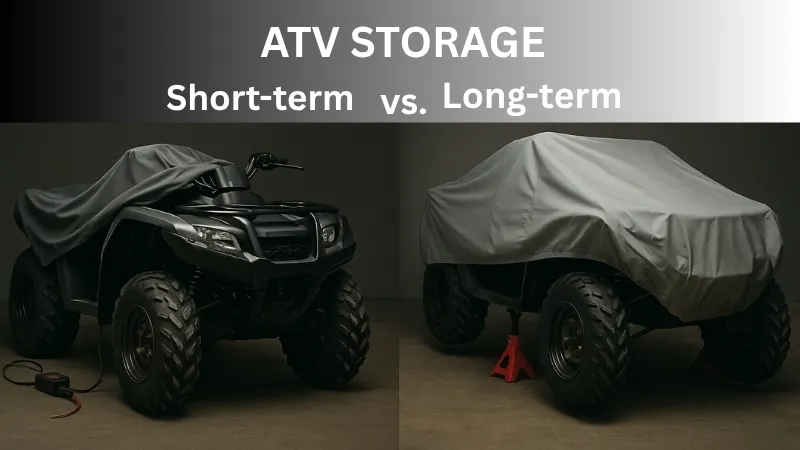
Short-Term vs Long-Term ATV Storage
How long you plan to park your ATV shapes the way you should prepare it. Short-term storage focuses on readiness, while long-term storage emphasizes preservation.
- Short-Term (Under 1 Month): For brief breaks, keep the fuel tank full to reduce condensation, charge the battery occasionally, and cover the ATV in a cool, dry area to keep dust and moisture off.
- Long-Term (1 Month+): Before extended storage, change the oil, add a fuel stabilizer, disconnect the battery, inflate the tires properly, and lift the machine slightly to reduce suspension strain.
- Humidity Control: If your storage space is enclosed, use moisture absorbers, such as silica gel packs, to prevent internal condensation that can trigger rust and corrosion.
- Rodent Barriers: Plug the air intake and exhaust with foam or steel wool to stop pests from crawling inside and causing expensive wiring or filter damage.
- Proper Covering: Always use a high-quality, breathable cover — plastic tarps trap moisture underneath and cause more harm than protection.
Once you’ve decided how long your ATV will be resting, the next big question is where to keep it — because location can make or break your entire storage plan.
Choosing the Right Storage Location
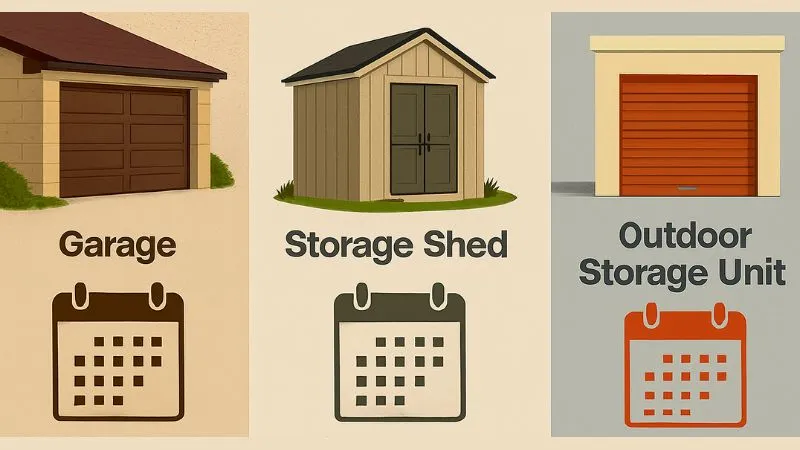
The right location for ATV storage can make or break your maintenance efforts. Pick a place that balances protection, ventilation, and accessibility.
- Garage: A clean, ventilated garage offers stable temperature, protection from rain and sunlight, and convenient access to outlets for battery charging.
- Storage Shed: A weather-sealed shed is a great middle-ground, providing protection from UV and rain, but you should add ventilation and seal gaps to prevent rodent entry.
- Outdoor Area: If you must store outside, choose a paved or wooden surface, use a waterproof yet breathable cover, and apply rust inhibitor spray to all exposed metal.
- Self-Storage Unit: For those in apartments or humid climates, climate-controlled self-storage facilities offer stable temperatures, 24/7 security, and moisture-free conditions.
Now, it’s time to prepare it properly — the real magic of storage isn’t just where you park it, but how you put it to sleep.
Preparing Your ATV for Storage
A little preparation ensures your ATV wakes up in perfect condition months later. Think of this as the tune-up before hibernation.
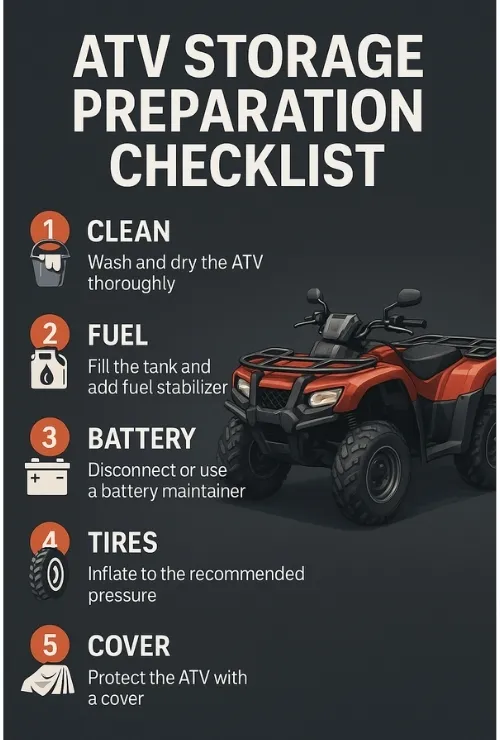
- Clean It Thoroughly: Wash off mud, salt, and debris with a mild detergent, dry completely, and apply a silicone spray or rust inhibitor to keep the metal spotless and corrosion-free.
- Change Fluids: Replace old oil, coolant, and brake fluid since these can become acidic over time, damaging seals and bearings when left sitting.
- Stabilize or Drain Fuel: Add a stabilizer to a full tank for long-term storage or drain it completely if required by storage rules, preventing sticky varnish buildup in lines.
- Care for the Battery: Disconnect the terminals and connect a battery maintainer indoors to avoid freezing temperatures and maintain charge consistency.
- Protect the Tires: Inflate to the manufacturer’s PSI and use tire blocks or jack stands to prevent flat spots and cracking from pressure or cold floors.
- Block Rodents and Moisture: Plug openings with foam or mesh, and use peppermint oil or moisture absorbers around the area to deter pests and humidity.
- Cover Securely: Always use a breathable, water-resistant cover and secure it tightly to avoid flapping and moisture buildup.
Now that your ATV is cleaned, treated, and covered, fully prepared to be stored. Now, what? STORAGE. Yes, but what to do when you don’t have indoor space — because outdoor storage demands its own layer of protection.
Read: What to Do If Your ATV Makes Buzzing Sound When You Try to Start It
Outdoor Storage & Covers – When Indoor Isn’t Available
Not everyone has a garage or climate-controlled unit. Sometimes your ATV has to sit under the open sky — and that’s perfectly manageable if you prepare correctly.
Outdoor ATV storage demands more attention to weather, moisture, and sunlight, but with the right tools and a little foresight, your four-wheeler can stay in great shape until the next ride.
Read: Why Are Front Tires in ATV Smaller Than The Rear Tires?
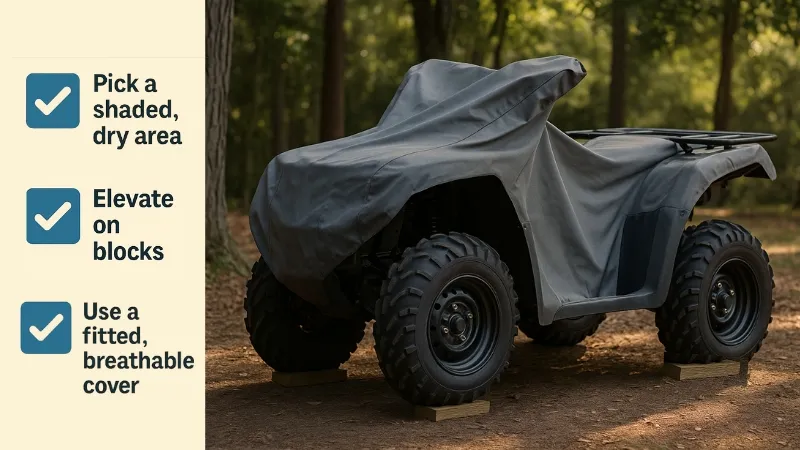
Challenge of Storing an ATV Outdoors
Sunlight, rain, and temperature swings attack every part of your machine.
- UV rays fade plastic bodywork and dry out vinyl seats.
- Rain and dew creep into joints and electrical connectors, leading to corrosion.
- Temperature changes cause metal parts to expand and contract, loosening bolts and seals.
- Dust, leaves, and insects collect in air intakes and under panels.
That’s why proper outdoor ATV storage isn’t about “where you park it,” but “how you protect it.”
Choose the Right Parking Surface
The ground under your ATV matters as much as the cover above it.
- Park on concrete, asphalt, or treated wood rather than bare soil or grass, which hold moisture that accelerates rust.
- Place rubber mats or plywood boards under the tires to insulate them from cold or damp surfaces.
- Use tire blocks or jack stands to relieve pressure and prevent flat spots.
These small steps protect your suspension and keep rust from creeping up through the frame.
Use a Quality ATV Cover — Not a Tarp
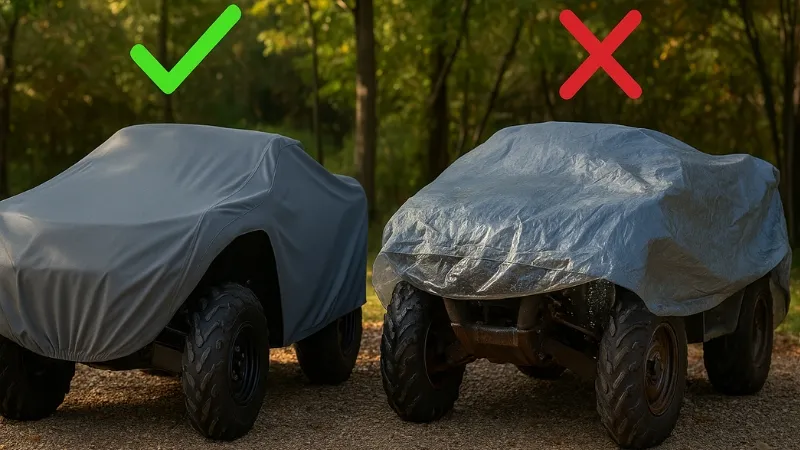
The single best defense against the elements is a breathable, waterproof ATV cover.
- Look for UV-resistant materials like polyester or Oxford fabric with a waterproof coating.
- Ensure it’s ventilated to release condensation and tailored to your model for a snug fit.
- Secure it with elastic hems or tie-downs to prevent flapping in strong winds.
Avoid cheap plastic tarps; they trap moisture underneath and turn your quad into a rust incubator. A dedicated ATV cover keeps water out while letting air circulate — exactly what long-term outdoor protection requires.
Add Extra Layers of Defense
A good cover helps, but true protection comes from layered safeguards:
- Rust Inhibitor Spray: Mist on metal parts, bolts, and the exhaust to block oxidation.
- Moisture Absorbers: Place silica-gel or calcium-chloride packs under the seat or near electronics to manage humidity.
- Rodent Deterrents: Use peppermint oil or ultrasonic devices around the storage area to keep pests out of wiring and air boxes.
- Wheel Locks or Chains: Outdoor spaces invite theft — lock the frame to a secure anchor for peace of mind.
Together, these measures create an invisible shield against weather, moisture, and mischief.
Seasonal Outdoor Storage Tips
If you’re facing a long off-season:
- Reapply protective sprays every few weeks if the area is exposed to rain or salt air.
- Inspect the cover for tears and tighten straps after heavy wind.
- During the snow season, clear heavy buildup from the cover to avoid stretching or tearing.
A quick monthly walk-around ensures your machine stays in top condition even when you can’t ride.
With your outdoor setup secure, the next challenge is time — because when storage stretches into months, your ATV needs deeper protection to handle the long haul.
Long-Term Storage Specifics – Seasonal or Off-Season
When your ATV sits for more than a month, short-term tricks aren’t enough. Long-term or seasonal storage — whether through a harsh winter, humid monsoon, or sweltering summer — demands extra care.
The goal isn’t just to park your machine safely; it’s to preserve its internal systems so it wakes up exactly as you left it.
1. Winterizing Your ATV

Cold weather creates unique problems: thickened oil, frozen fuel, and moisture that condenses in the wrong places. Winterizing ensures your ATV survives the freeze without damage.
- Fuel System Treatment: Add a fuel stabilizer, fill the tank, and run the engine so treated fuel reaches injectors and lines. This prevents varnish and water accumulation.
- Oil and Filter Change: Fresh oil resists condensation and acid buildup better than used oil. Replace before winter hits.
- Antifreeze Check: Verify coolant strength to avoid freezing in the radiator and engine block.
- Battery Care: Disconnect and attach a battery maintainer in a sheltered spot; cold drains batteries faster than heat.
- Seal and Cover: Plug exhaust and intake ports with foam to block rodents and moisture, then cover the ATV with a breathable, waterproof cover.
These small moves keep your quad from turning into an ice-cold paperweight by spring.
2. Preparing for Humid or Rainy Climates
If you’re in a tropical or coastal area, humidity — not frost — is your enemy. The constant presence of moisture can trigger rust, mildew, and electrical oxidation.
- Use silica gel or calcium-chloride moisture absorbers around the ATV to pull humidity from the air.
- Apply rust inhibitor spray to exposed bolts, frame joints, and chain links.
- Keep your ATV cover slightly elevated or vented to allow airflow; never seal it airtight.
- Wipe down plastics and seat vinyl with a UV-protectant conditioner to prevent fading and cracking.
For long-term storage in damp conditions, ventilation matters more than insulation.
3. Deep Preservation Steps (3 Months +)
When you’re storing for an entire off-season or longer, add these advanced preservation techniques:
- Fog the Engine: Spray engine fogging oil into the intake while idling, then shut down. It coats cylinder walls and prevents rust inside the engine.
- Lubricate Moving Parts: Grease pivot points, cables, and the chain. This prevents binding and corrosion during long inactivity.
- Elevate and Rotate: Keep the ATV on jack stands to relieve pressure on shocks and tires. Rotate the wheels monthly to prevent suspension fatigue.
- Drain Carburetors (for carb models): Residual fuel evaporates and leaves sticky residue. Draining bowls avoids rebuild headaches later.
- Cover Electronics: Use light plastic wrap or bags over digital displays and connectors to block dust and moisture.
These details are what separate a quick storage job from professional-grade protection.
4. Security and Safety Considerations
Seasonal downtime also means your ATV becomes an easy target if not secured properly.
- Use wheel locks or a frame-anchored chain for outdoor units.
- If in a self-storage facility, confirm security cameras and controlled access.
- For home setups, install motion lights or a small Bluetooth tracker under the seat.
Protecting your machine mechanically is one thing; safeguarding it physically completes the job.
Long-Term Storage Recap
| Step | Purpose | Recommended Tools / Entities |
| Fuel Stabilize | Prevent varnish and water in fuel lines | Fuel Stabilizer, Treated Fuel |
| Oil & Coolant Refresh | Stop acid corrosion | Engine Oil, Coolant |
| Moisture & Rust Control | Prevent oxidation | Rust Inhibitor Spray, Moisture Absorber |
| Engine Protection | Coat internals | Fogging Oil |
| Tire & Suspension Care | Reduce pressure damage | Jack Stands, Tire Blocks |
| Battery Maintenance | Extend battery life | Battery Maintainer / Trickle Charger |
| Security Setup | Prevent theft | Wheel Lock, Frame Anchor |
Now, with ATV’s long-term setup is complete, the next big step is bringing it back to life — and doing that safely requires just as much care as putting it to sleep.
Read: An in-depth Guide to Testing an ATV Starter
Waking Your ATV from Storage
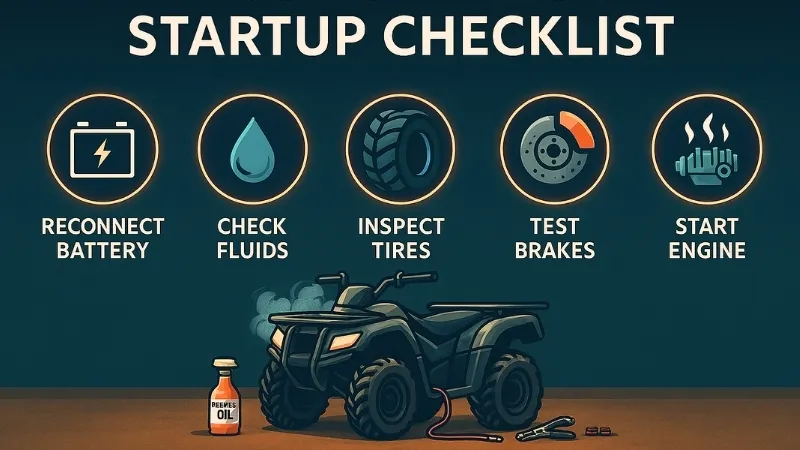
When it’s time to ride again, start your ATV slowly and inspect everything. These checks prevent early-season breakdowns and extend your ATV’s lifespan.
- Reconnect the Battery: Reinstall or reconnect terminals tightly, check voltage, and charge fully before the first startup to ensure smooth cranking.
- Inspect the Fuel System: Check for bad-smelling or discolored gas, replace it if stale, and examine fuel lines for leaks or brittleness before running.
- Check Fluids: Confirm that oil, coolant, and brake fluid levels are correct, topping off or replacing if any seem cloudy or low.
- Inspect Tires and Suspension: Inflate to spec, check for cracks or flat spots, and make sure shocks and seals compress and rebound smoothly.
- Test Brakes and Controls: Move throttle, clutch, and brake levers to confirm smooth, responsive operation without sticking or stiffness.
- Start Slowly: Crank the engine in short bursts, let it idle for several minutes, and check for unusual noises, leaks, or smoke before revving.
- Take a Gentle Test Ride: Ride slowly for a few minutes to let fluids circulate and confirm everything feels balanced before resuming normal use.
Common Storage Mistakes to Avoid
Even seasoned riders overlook critical steps that lead to costly repairs later. Avoiding these simple errors keeps your ATV in top shape all year.
- Storing It Dirty: Mud and salt left on metal parts trap moisture and promote corrosion, so always wash and dry before putting it away.
- Leaving Old Fuel: Ethanol fuel breaks down fast and can clog carburetors or injectors, so use a stabilizer or drain the system before storage.
- Ignoring the Battery: Without maintenance charging, your battery can discharge beyond recovery, leaving you stranded come spring.
- Letting Tires Sit Flat: Constant pressure causes flat spots and cracks, so inflate properly or elevate to reduce stress on rubber and suspension.
- Skipping Rodent Prevention: Mice can destroy wiring overnight, so seal all openings and place repellents or traps around your ATV.
- Using a Plastic Tarp: Tarps lock in condensation, creating a rust incubator, whereas breathable covers protect while allowing airflow.
- Skipping the Startup Check: Firing up without inspecting fluids or controls can cause engine wear or brake failure right from the first ride.
Key Takeaways

Good storage is an essential part of ATV ownership, not an afterthought. With care and preparation, your ATV will always be ready for adventure.
- Clean, dry, and protect every surface before parking for the season to prevent rust and decay.
- Use fuel stabilizers, fresh oil, and a battery maintainer to preserve internal systems and electrical life.
- Cover smartly — breathable, water-resistant fabric prevents condensation while shielding from dust and UV.
- Choose your storage type based on time and climate: garages or sheds for short-term, climate-controlled spaces for long-term.
- Before every restart, perform a full safety and maintenance check to ensure smooth, damage-free performance.
Protect Your ATV Today, Enjoy It Tomorrow
Proper ATV storage isn’t a chore — it’s an investment in every future ride. Whether you’re storing for a few weeks or an entire season, the small steps you take now determine how smoothly your machine performs when adventure calls again.
A clean All-Terrain Vehicle, a charged battery, stabilized fuel, and a snug breathable cover — that’s all it takes to prevent corrosion, electrical failures, and costly repairs down the line. Add in a climate-controlled unit or a well-ventilated shed, and you’ve already done what most riders overlook.
Think of it like this: storing your ATV right isn’t about parking it — it’s about preserving performance. The time you spend today cleaning, prepping, and covering your quad saves you from the frustration of a dead battery or seized brakes when trail season returns.
So before you hang up your helmet for the off-season, give your ride the attention it deserves. Follow this ATV storage guide, avoid the common mistakes, and your machine will be ready to roar the moment you are.
Because in the end, real off-roaders don’t just ride hard — they store smart.
FAQs – Quick Answers for ATV Owners
How long can I store an ATV without using it?
You can safely store an All-Terrain Vehicle for up to a few months if it’s properly prepared — clean, fueled with a stabilizer, and connected to a battery maintainer. For storage beyond six months, take full long-term measures like engine fogging and tire elevation.
Can I store my ATV outside?
Yes, but outdoor ATV storage requires extra protection. Always park on a dry surface, cover the ATV with a breathable, waterproof cover, and use rust inhibitor spray on metal parts. Add rodent deterrents and moisture absorbers if you live in a humid or coastal area.
Do I need a climate-controlled storage unit for my ATV?
It’s not mandatory, but highly recommended if you face extreme heat, cold, or humidity. A climate-controlled self-storage unit prevents corrosion, protects the battery, and maintains consistent air quality. It’s ideal for long-term or winter storage.
Should I remove the battery before storing my ATV?
If you’re storing for more than a few weeks, yes. Remove the battery and keep it on a trickle charger indoors. This prevents voltage loss and extends battery life, especially in cold or damp conditions.
What size storage unit do I need for an ATV?
A 5×10 storage unit fits most standard ATVs and quads, leaving room for gear and accessories. Larger models or side-by-sides (UTVs) may require a 10×10 or 10×15 unit. Always check your ATV’s dimensions before renting.
Do I need to drain the fuel before storage?
Only if the storage facility requires it or if you’ll be parking for over six months. Otherwise, add a fuel stabilizer, fill the tank completely, and run the engine briefly to circulate treated fuel.
How do I prevent rust while storing an ATV?
Wash and dry your ATV before storage, then apply a rust inhibitor spray or WD-40 to exposed bolts, frame joints, and the exhaust. Keep it in a dry, ventilated space and avoid using airtight plastic covers.
Why won’t my ATV start after storage?
Most post-storage start issues come from bad fuel, a drained battery, or clogged jets. Check your battery voltage, inspect the fuel for discoloration, and clean the carburetor or injectors. Always follow your ATV startup checklist before riding.
Can I keep my ATV insured while in storage?
Yes, and you should. Many insurers offer storage insurance or comprehensive coverage for non-use periods to protect against theft, fire, or damage. It’s usually affordable and worth the peace of mind.
Relevant reads include: